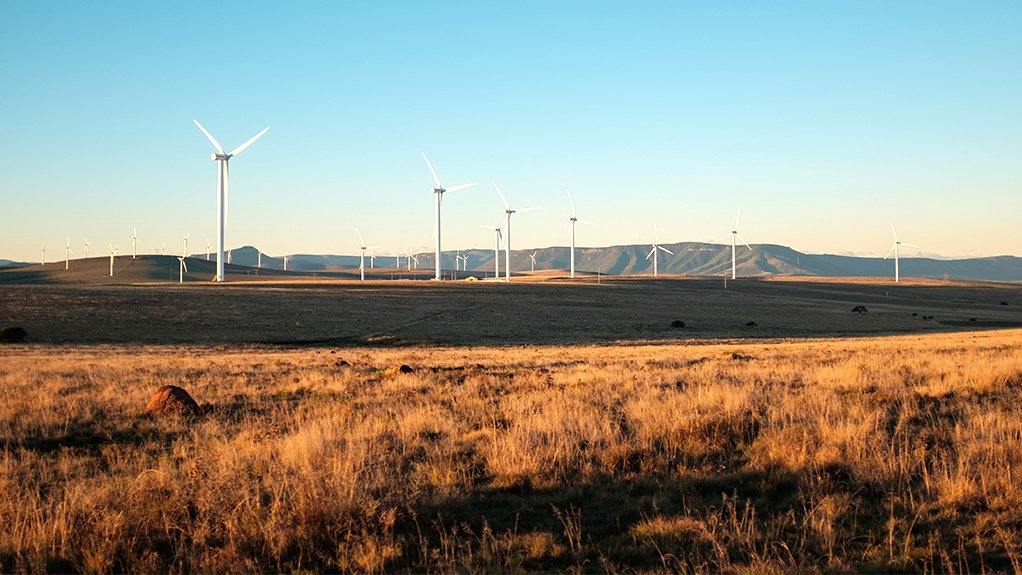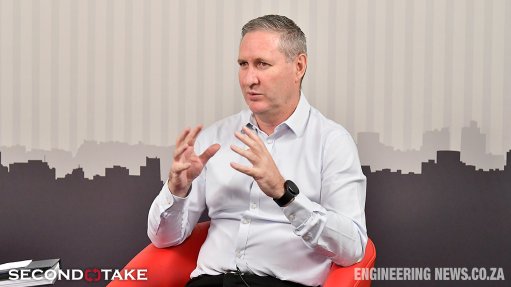Global report forecasts 5.4 GW of new wind additions in South Africa to 2026
The Global Wind Energy Council (GWEC) is forecasting that South Africa will add 5.4 GW of new wind capacity over the coming five years to the end of 2026, even though procurement delays will lead to lower levels of deployment in 2022 when compared with 2021.
GWEC’s ‘Global Wind Report 2022’ notes that South Africa remains the largest wind market in sub-Saharan Africa, with about 3.1 GW of capacity already connected to the grid.
South Africa installed a record 668 MW in 2021 - capacity linked primarily to projects procured as part of the much-delayed fourth bid window (BW4) of the Renewable Energy Independent Power Producer Procurement Programme (REIPPPP).
The report expects installations to be lower in 2022, owing to renewed procurement delays, as well as the fact that projects procured under BW5 will enter commercial operation within three years.
Twelve wind projects were selected as preferred bids following the adjudication of BW5 submissions last year and the projects are currently scheduled to achieve financial close at the end of April.
“The latest BW5 in October 2021 attracted bids amounting to nearly four times the capacity awarded, resulting in a record 12 wind farms winning bids,” the report states, adding that 46 wind projects have, to date, been awarded to various developers under the REIPPPP.
GWEC expects the growth momentum in South Africa to be maintained during the rest of the forecast period to 2026.
“In total, 14 GW of new capacity is expected to be added in Africa/Middle East in the next five years (2022-2026), which is primarily driven by growth from South Africa (5.4 GW), Egypt (2.2 GW) and Morocco (1.8 GW) in Africa, and Saudi Arabia (1.3 GW) in the Middle East.”
The report also notes that South Africa’s Integrated Resource Plan to 2030 outlines a primary role for renewable energy in the future power mix, requiring an additional 20.4 GW of renewable energy capacity in this decade.
It also highlights the country’s 2021 Nationally Determined Contribution (NDC) pledge to limit greenhouse gas emissions to between 420-million and 350-million tons of carbon dioxide-equivalent emissions by 2030 – a 12% to 31% reduction from the country’s previous NDC of 2016.
“Timely implementation of these strategies will be necessary to decarbonise the power system in South Africa, and will include addressing some of the financial and operational challenges of the State-owned utility Eskom, as well as committing to regular procurement of large-scale renewable-energy projects,” the report states.
The ongoing restructuring of Eskom, including the creation of an independent transmission entity, together with a market reform enabling sub-100 MW projects to proceed without a licence, “will further incentivise renewable-energy development”, as could the “milestone” COP26 offer of $8.5-billion to support South Africa’s just transition away from coal.
The South African energy market still has key challenges to overcome, however, with the report indicating that further regulatory changes will be necessary to support the transition to cleaner sources.
“Investors and financiers require as much policy certainty as possible, with supportive frameworks which allow for wheeling and the signing of direct power purchase agreements with independent power producers without Ministerial approval.
“Stable pipelines of wind projects can be created through continuous and regular capacity procurement, including a long-term and on-time auction schedule, as well as a more robust REIPPPP process which can minimise delays for selection and contract completion.”
The report warns that grid constraints in the three provinces of the Eastern, Northern and Western Cape are curtailing the roll-out of shovel-ready projects and affecting investment certainty.
The report expresses some optimism, however, that an imminent Generation Connection Capacity Assessment report could provide more clarity on capacity planning and
transmission connections.
It also notes that new wind resource assessments are under way in Mpumalanga, which could unlock further deployment.
The pipeline of wind power has created jobs and the local manufacture of components such as towers and transformers, but GWEC says the lack of predictability for future renewables procurement has introduced some uncertainty to the local value chain.
“A more straightforward approach to local content requirements, accounting for existing and planned local manufacturing capacity as well as training and financial provisions for the local workforce, can help build a more sustainable local industry.”
Globally, GWEC expects 557 GW of new capacity to be added in the next five years under current policies, which it says falls behind the milestones required for a 1.5 °C pathway. Yearly installations would have to grow by four times this decade to meet that goal.
Besides improved market signals and incentives to meet that objective, the report also warns of serious permitting backlogs and ongoing red tape preventing the accelerated construction of both onshore and offshore wind projects.
Immediate supply chain disruptions and the rising costs of key inputs such as steel, copper and freight rates are also set to result in wind pricing increases in the near term, while the lack of investment in grids, logistics highways and ports poses a risk to increased wind investment over the medium term.
Comments
Press Office
Announcements
What's On
Subscribe to improve your user experience...
Option 1 (equivalent of R125 a month):
Receive a weekly copy of Creamer Media's Engineering News & Mining Weekly magazine
(print copy for those in South Africa and e-magazine for those outside of South Africa)
Receive daily email newsletters
Access to full search results
Access archive of magazine back copies
Access to Projects in Progress
Access to ONE Research Report of your choice in PDF format
Option 2 (equivalent of R375 a month):
All benefits from Option 1
PLUS
Access to Creamer Media's Research Channel Africa for ALL Research Reports, in PDF format, on various industrial and mining sectors
including Electricity; Water; Energy Transition; Hydrogen; Roads, Rail and Ports; Coal; Gold; Platinum; Battery Metals; etc.
Already a subscriber?
Forgotten your password?
Receive weekly copy of Creamer Media's Engineering News & Mining Weekly magazine (print copy for those in South Africa and e-magazine for those outside of South Africa)
➕
Recieve daily email newsletters
➕
Access to full search results
➕
Access archive of magazine back copies
➕
Access to Projects in Progress
➕
Access to ONE Research Report of your choice in PDF format
RESEARCH CHANNEL AFRICA
R4500 (equivalent of R375 a month)
SUBSCRIBEAll benefits from Option 1
➕
Access to Creamer Media's Research Channel Africa for ALL Research Reports on various industrial and mining sectors, in PDF format, including on:
Electricity
➕
Water
➕
Energy Transition
➕
Hydrogen
➕
Roads, Rail and Ports
➕
Coal
➕
Gold
➕
Platinum
➕
Battery Metals
➕
etc.
Receive all benefits from Option 1 or Option 2 delivered to numerous people at your company
➕
Multiple User names and Passwords for simultaneous log-ins
➕
Intranet integration access to all in your organisation





















